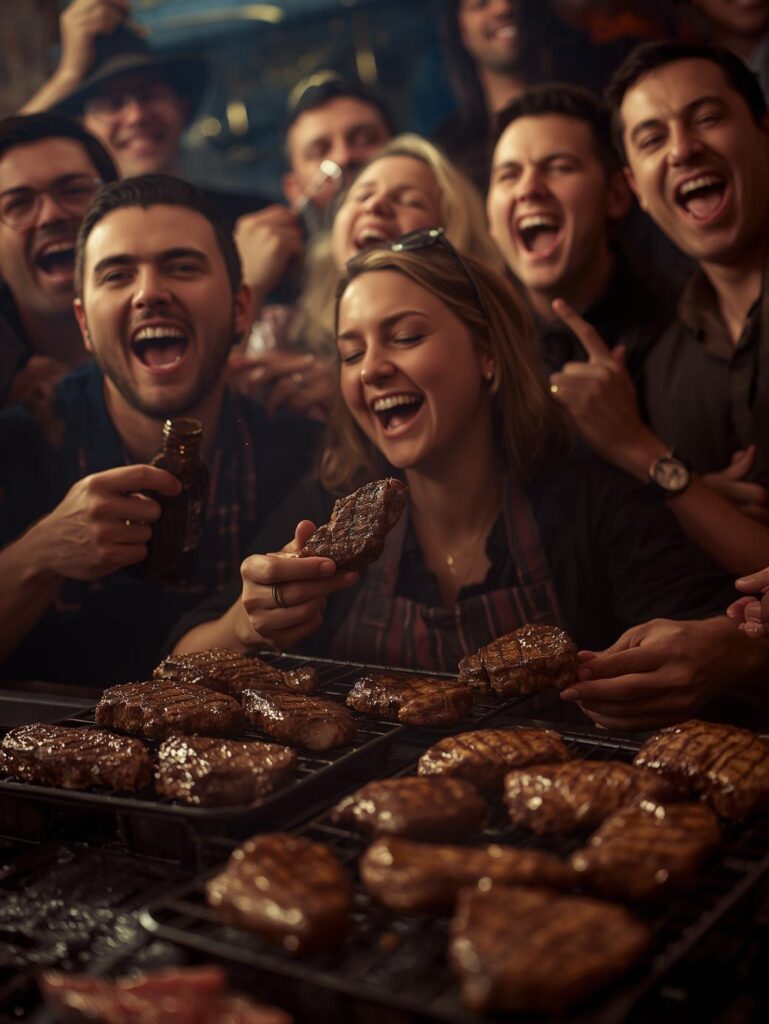Expert’s Note: Welcome to the ultimate destination for BBQ fans and steak lovers. This hub connects the two greatest passions in the world of meat: the low-and-slow art of barbecue and the high-heat perfection of steak. Whether you’re tending a 12-hour brisket or searing a 2-inch ribeye, you’ve found your community. This is where fire, flavor, and technique converge.
BBQ Fans & Steak Lovers: Your Ultimate Guide to Fire, Smoke, and Sear
“BBQ is the patient conversation with smoke over hours, a meditation in tenderness. Steak is the passionate, quick-fire romance with high heat, a pursuit of the perfect crust. To master one is to understand the other. The true meat master doesn’t choose between them—they wield both with equal respect and skill, understanding that every cut has its perfect path to perfection.”
BBQ Fans & Steak Lovers: The Ultimate Guide to Cuts, Techniques & Tips 2025
Download the BBQ & Steak Method Matrix - Know Your Technique for Every Cut
Welcome to Meat Cuts Master, the new home for those who live by the fire. If you’re here, you understand that BBQ and steak aren’t just ways of cooking—they’re cultures, passions, and lifelong pursuits. This guide is your starting point, your compass in the world of meat. We’ll explore the fundamental philosophies, essential techniques, and must-know cuts that define greatness for both BBQ enthusiasts and steak aficionados.
🎯 THE TWO PILLARS OF MEAT MASTERY
Understanding the core difference between BBQ and steak grilling is your first step to mastery.
⚙️ The BBQ vs. Steak Grilling Philosophy
Two Different Arts, One Shared Passion
- BBQ (Low & Slow): The art of transformation. It uses low temperatures (200-275°F) and long cooking times (4-18 hours) to break down tough connective tissues in less tender cuts. The goal is to make the unyielding tender, using smoke as a primary flavor agent. It’s a test of patience and fire management.
- Steak Grilling (High Heat): The art of celebration. It uses high temperatures (400-600°F) and short cook times (4-15 minutes) to honor the inherent quality of already-tender cuts. The goal is to create a flavorful crust via the Maillard reaction while preserving a perfect interior. It’s a test of precision and timing.
- The Connection: Both require understanding fire, meat science, and the patience to let results unfold on their own schedule. Mastering temperature control is the golden key that unlocks both domains.
🎯 Are You a BBQ Fan or a Steak Lover? (Why Not Both?)
🔥 The BBQ Fan’s Profile
- Loves the journey as much as the destination
- Geek out on smoke rings and bark formation
- Patient, meticulous, and a master of fire management
- Favorite words: “low and slow,” “bark,” “probe-tender”
- Signature Cuts: Brisket, Pork Shoulder, Beef Ribs
🥩 The Steak Lover’s Profile
- Seeks the perfect sear and precise doneness
- Appreciates the pure, unadulterated flavor of beef
- Quick, precise, and a master of high-heat searing
- Favorite words: “crust,” “medium-rare,” “reverse sear”
- Signature Cuts: Ribeye, Strip, Filet Mignon, Picanha
🔪 THE CUT DICTIONARY: MATCHING MEAT TO METHOD
The single most important decision you make happens at the butcher counter.
🥓 BBQ Cuts (Tough Cuts, Tender Results)
Low and Slow Champions
- Brisket (The King of BBQ): The ultimate test of patience. A tough, heavily worked pectoral muscle that transforms into smoky, buttery perfection after 12-16 hours of smoke. It demands respect and unwavering temperature control.
- Pork Shoulder/Butt (The People’s Champion): Forgiving, flavorful, and perfect for pulled pork. Richly marbled with connective tissue that renders into succulent, shreddable meat. A great cut for beginners to learn low-and-slow principles.
- Beef Short Ribs (The Flavor Bomb): Incredibly beefy and marbled. When smoked low and slow, they become fall-off-the-bone tender with an intense, concentrated beef flavor that’s unmatched.
- Pork Spareribs (The Classic): The cornerstone of rib culture. Balance of meat, fat, and bone that responds beautifully to the 3-2-1 method or low-and-slow smoke.
🥩 Steak Cuts (Naturally Tender, Heat-Honored)
High Heat Heroes
- Ribeye (The King of Steak): The perfect balance of intense beefy flavor and incredible tenderness, thanks to abundant marbling. The spinalis dorsi (ribeye cap) is considered by many to be the single best bite of beef.
- New York Strip (The Steakhouse Standard): Bold, beefy flavor with a firmer texture than ribeye. A reliable, flavorful cut with a good fat cap that renders beautifully on a hot grill.
- Filet Mignon (The Tenderness Emperor): The most tender cut, with a mild, buttery flavor. Its leanness means it benefits from basting with butter or wrapping in bacon to add fat and flavor.
- Picanha (The Brazilian Secret): Also known as sirloin cap or rump cover. A hugely flavorful cut with a thick fat cap that self-bastes the meat. A staple of Brazilian churrascarias and a rising star worldwide.
📊 The Ultimate BBQ & Steak Cut Matrix
🎯 Your Guide to Choosing the Right Cut for the Right Method
| Cut | Primary Method | Target Internal Temp | Key Characteristic | Skill Level |
|---|---|---|---|---|
| Brisket | Low & Slow Smoke | 200-205°F (Probe Tender) | Tough to Tender Transformation | Expert |
| Pork Shoulder | Low & Slow Smoke | 195-205°F (Shreddable) | Forgiving, Fat-Rich | Beginner+ |
| Beef Short Ribs | Low & Slow Smoke | 200-205°F (Probe Tender) | Intense Beef Flavor | Intermediate |
| Ribeye | High Heat Grill/Reverse Sear | 128-133°F (Medium-Rare) | Maximum Marbling | All Levels |
| New York Strip | High Heat Grill | 128-133°F (Medium-Rare) | Bold, Beefy Flavor | All Levels |
| Filet Mignon | Pan Sear/Grill | 125-130°F (Rare-Medium Rare) | Ultimate Tenderness | All Levels |
| Picanha | High Heat Grill (Skewered) | 128-133°F (Medium-Rare) | Self-Basting Fat Cap | Intermediate |
🔥 THE TECHNIQUE TOOLKIT: ESSENTIAL METHODS FOR EVERY COOK
Master these foundational techniques and you can conquer any cut of meat.
🎪 BBQ Techniques (The Low & Slow Arsenal)
The Art of Patience and Smoke
- The Two-Zone Fire: The most important concept in BBQ. You create a hot zone (for searing if needed) and a cool zone (for indirect cooking). This is your temperature control safety net and the key to preventing burnt food.
- Low & Slow Smoking: Maintaining a consistent temperature between 225-275°F for hours on end. The goal is to keep the meat in the “stall” zone (150-170°F) long enough for connective tissue to break down without the exterior burning.
- The Texas Crutch: Wrapping meat (usually brisket or ribs) in butcher paper or aluminum foil partway through the cook to power through the stall and preserve moisture.
- Probe for Tenderness, Not Just Temp: With BBQ, internal temperature is a guide, but tenderness is the goal. The probe should slide into the meat with little to no resistance, like pushing into a jar of peanut butter.
⚡ Steak Techniques (The High-Heat Playbook)
The Pursuit of the Perfect Crust
- The Reverse Sear: The modern gold standard for thick steaks. Cook the steak gently with indirect heat until it’s 10-15°F below your target temperature, then sear it at very high heat to create the crust. This eliminates the gray band and provides edge-to-edge perfect doneness.
- Direct High-Heat Grilling: The classic method for steaks up to 1.5 inches thick. Simple, effective, and delivers a great crust. Requires careful attention to prevent burning.
- Sous Vide + Sear: The ultimate in precision. Cook the steak to the exact temperature in a water bath, then pat it dry and sear it violently for 45-60 seconds per side. Impossible to overcook (until the sear).
- The Rest is Non-Negotiable: Always rest your steak for 5-10 minutes after cooking. This allows the juices to redistribute throughout the meat. If you slice immediately, the juices will end up on your cutting board.
🧂 THE FLAVOR LAB: SEASONING, RUBS, AND SAUCES
Building layers of flavor from the basics to the advanced.
🧂 BBQ Flavor Profile
Layers of Smoke and Spice
- The Rub: The primary flavor agent. Usually a balance of salt, sugar (for bark and caramelization), paprika (for color), and spices (garlic powder, onion powder, chili powder, cumin).
- The Smoke: Wood selection is crucial. Hickory for strong flavor, oak for medium, fruitwoods (apple, cherry) for sweet and mild. The smoke should be a thin, blue smoke—white, billowy smoke tastes bitter.
- The Sauce (If Used): Applied in the last 30-60 minutes of cooking or served on the side. Regional styles vary wildly from vinegar-based (Carolina) to sweet and thick (Kansas City).
- The Binder: A light coating of mustard, oil, or hot sauce helps the rub adhere to the meat. It doesn’t affect the final flavor.
🌿 Steak Flavor Profile
Celebrating the Beef
- The Dry Brine: Salting the steak 1-24 hours before cooking. This seasons the meat deeply, improves juiciness, and dries the surface for a better sear. The single biggest upgrade for steak.
- Salt and Pepper: Often, this is all you need. Use coarse salt and add black pepper after searing (it burns easily).
- Compound Butters: A pat of butter mixed with herbs, garlic, or shallots melting over a rested steak adds richness and freshness.
- Finishing Salts: A sprinkle of flaky sea salt (like Maldon) after slicing provides texture and a burst of salinity.
🚨 TROUBLESHOOTING: FIXING COMMON BBQ & STEAK PROBLEMS
🎯 Quick Solutions for When Things Go Wrong
| Problem | BBQ Issue | Steak Issue | Universal Fix |
|---|---|---|---|
| Dry/Tough Meat | Didn’t cook long enough; collagen didn’t render. | Overcooked; muscle fibers tightened too much. | BBQ: Cook to tenderness, not time. Steak: Use a thermometer; don’t guess. |
| Burnt Exterior | Sugar in rub burned; temp too high; no water pan. | Heat too high for too long; too close to coals. | Manage heat with two-zone setup; use sugar-free rubs for high heat. |
| Lacks Flavor | Underseasoned; weak smoke; sauce too early. | Underseasoned; poor sear (Maillard reaction failed). | Season aggressively; ensure dry surface for sear; use quality wood. |
| Uneven Cooking | Hot spots in smoker; didn’t rotate meat. | Uneven thickness; cold spots on grill. | Rotate meat; choose evenly cut meat; learn your equipment’s hot spots. |
🏁 YOUR JOURNEY BEGINS HERE
Whether your heart lies with the patient, smoky embrace of BBQ or the fiery, immediate gratification of the perfect steak, you are now equipped with the foundational knowledge to excel. Remember that every master was once a beginner. Start with the forgiving cuts—a pork shoulder for BBQ, a ribeye for steak. Master the basic techniques before moving to the advanced.
Your journey into the world of fire and flavor is just beginning. This website will be your guide, your resource, and your community. Bookmark this page, return to it often, and let it be the foundation upon which you build a lifetime of incredible meals.
The fire is waiting. The meat is calling. Your path to mastery starts now.
Essential Reading for Your Journey: Build your knowledge with these core guides.



